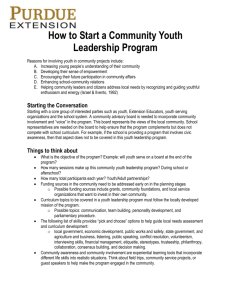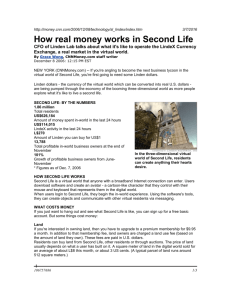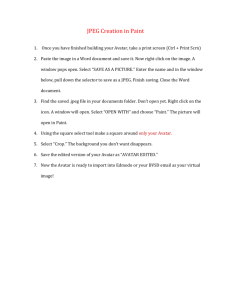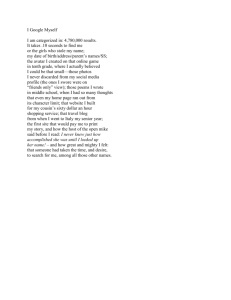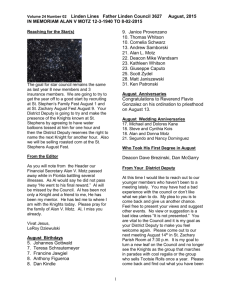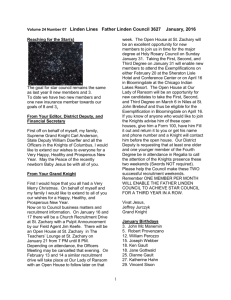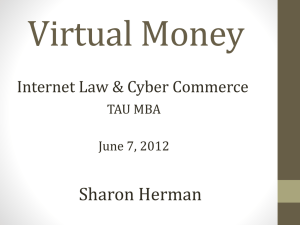Librarians Going Global in Second Life
advertisement
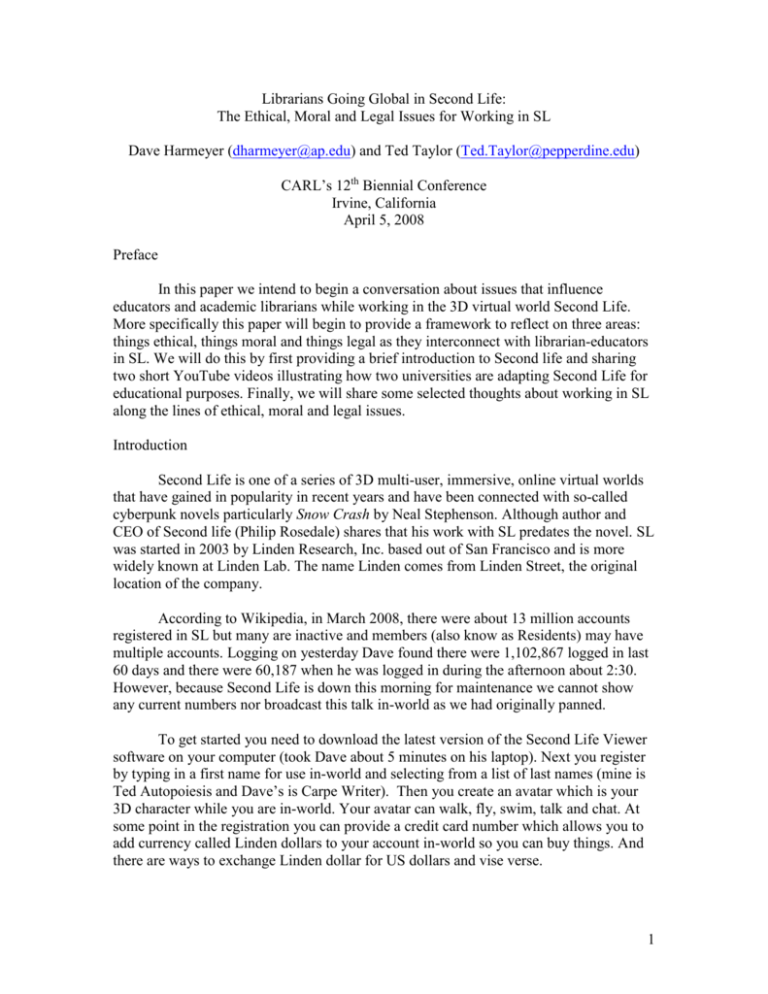
Librarians Going Global in Second Life: The Ethical, Moral and Legal Issues for Working in SL Dave Harmeyer (dharmeyer@ap.edu) and Ted Taylor (Ted.Taylor@pepperdine.edu) CARL’s 12th Biennial Conference Irvine, California April 5, 2008 Preface In this paper we intend to begin a conversation about issues that influence educators and academic librarians while working in the 3D virtual world Second Life. More specifically this paper will begin to provide a framework to reflect on three areas: things ethical, things moral and things legal as they interconnect with librarian-educators in SL. We will do this by first providing a brief introduction to Second life and sharing two short YouTube videos illustrating how two universities are adapting Second Life for educational purposes. Finally, we will share some selected thoughts about working in SL along the lines of ethical, moral and legal issues. Introduction Second Life is one of a series of 3D multi-user, immersive, online virtual worlds that have gained in popularity in recent years and have been connected with so-called cyberpunk novels particularly Snow Crash by Neal Stephenson. Although author and CEO of Second life (Philip Rosedale) shares that his work with SL predates the novel. SL was started in 2003 by Linden Research, Inc. based out of San Francisco and is more widely known at Linden Lab. The name Linden comes from Linden Street, the original location of the company. According to Wikipedia, in March 2008, there were about 13 million accounts registered in SL but many are inactive and members (also know as Residents) may have multiple accounts. Logging on yesterday Dave found there were 1,102,867 logged in last 60 days and there were 60,187 when he was logged in during the afternoon about 2:30. However, because Second Life is down this morning for maintenance we cannot show any current numbers nor broadcast this talk in-world as we had originally panned. To get started you need to download the latest version of the Second Life Viewer software on your computer (took Dave about 5 minutes on his laptop). Next you register by typing in a first name for use in-world and selecting from a list of last names (mine is Ted Autopoiesis and Dave’s is Carpe Writer). Then you create an avatar which is your 3D character while you are in-world. Your avatar can walk, fly, swim, talk and chat. At some point in the registration you can provide a credit card number which allows you to add currency called Linden dollars to your account in-world so you can buy things. And there are ways to exchange Linden dollar for US dollars and vise verse. 1 In Second Life there is a teen grid for minors 13 to 18. No adults are to be in this area. Everyone else 18 and older enters into the main Second Life grid. There is sleaze in Second Life in the form of just about anything you can imagine (nude beaches, “free sexorgy room”). By selecting the top 20 most popular places “as measured by traffic, the amount of time people spend there” there are usually 2 or 3 that are clearly sexually explicit. The media is quick to share the debase side of SL. For example, television news briefs tell of how a women entered into SL, met another male avatar where they progressed to get married with all the expenses and emotions that come with normal nuptials. Come to find out the male aviator was a real life married man and the women was more than heart broken. Or take the fall 2007 episodes of CSI and Law and Order where Second Life is a place where bad people go to stalk and kill people. Juxtaposed to the sleaze and dark side of SL is the relatively recent development of a large numbers of librarians and educators entering second life with a very different agenda. Since late 2006 and early 2007 these innovators and pioneers have been creating social learning spaces allowing students, faculty and librarians to engage in classroomlike settings, experimenting with new information tools and gaining insight into problems and solutions usually not possible in the real world. There are currently about 150 university, colleges and educational institutions from the US and abroad that have a presence in SL. Many schools have purchased what are called islands and have built simulated campuses and meeting areas. With this amount of synergy on the part of educator librarians and others in an environment the media states as a place of immorality, is it any wonder that university administrators are reluctant to endorse this new immersive education? Provosts and presidents are thinking they may be held accountable for bad decisions their students, librarians or faculty make in-world in different ways then accountability is understood in the face-to-face world. Let’s take the next six minutes to view two universities’ educational efforts in Second Life: Ohio University and San Jose State University’s School of Library & Information Science. Show Two videos Ohio University (2 minutes 33 seconds) http://www.youtube.com/watch?v=aFuNFRie8wA San Jose State University’s School of Library & Information Science (3 minutes 29 seconds) http://www.youtube.com/watch?v=j-9zt3Sd7oc Things Ethical A great deal of this morning’s topic in all three areas (ethical, moral and legal) for a librarian-educator can fall under the in-world phrase “griefing” the term used for avatar 2 harassment and/or assault. When griefing occurs in SL it usually means an avatar is harassing or assaulting another avatar such as stalking, throwing objects, pushing, etc. that deprives another individual of the intended purpose of SL as a positive social environment. Linden Lab’s “Terms of Service Agreement” (covered in more detail under things legal), clearly forbids harassment. From every ethical framework, griefing is unacceptable. According to the Markkula Center for Applied Ethics at Santa Clara University, ethical decision making “tells us how human beings ought to act in the many situations in which they find themselves” including immersive worlds and is not based on feelings, religion, law or following culturally accepted norms. Whether you apply the utilitarian approach (where the preferred action provides the greatest balance of good over harm) or the common good approach (where reasoning is based on respect for all others) or the virtue approach (where actions ought be inline with high character and values like truth, honesty, fairness and asks the question “what kind of person will I become if I do this?”) or any other ethical framework, griefing is incompatible. But these same ethical frameworks can also help provide useful scaffolding for meaningful dialogue on other issues confronting librarians and fellow educators pioneering in Second Life. I’ve been subscribing to the listerv SLED (Second Life Educators) for some time. Is there anyone on the SLED list? Well, in the past five months there have been at least three issues raised that have ethical implications. First, earlier this week there was an issue about changing your avatar’s clothes in front of your class. Doing this causes your avatar to be nude for a period of time. There were more than a few messages about how this should be done. Some felt the avatar was merely a tool and being nude didn’t matter. Others felt very different and that their avatar was an extension of the person. So, SLED colleagues were sharing how to build temporary change closets and other devises to make the clothes-change less embarrassing. A second issue raised in an early January 2008 SLED conversation was the ethical (and legal) implications of copying chat records (recorded in-world) during a class discussion and transferring them outside SL without consent. They were sharing best practices about how some web-based tool can easily move IM conversations outside of SL. Without an Institutional Review Board in place, such slips in ethical dealings with students could come back and bite you in litigation. An ethical framework can help think through this consent issue including stripping personal information from achieved messages. Finally, back in November 2007, members were discussing the implications of a United Kingdom researcher who used a Second Life avatar bot to invade peoples’ private space to study social behavior. Some felt that being rude was not unethical and that experimenting like this in-world was not any different than experiments by other highly respected researchers years ago. Seems to me that an ethical framework would be valuable in these kinds of real in-world education dilemmas. 3 Things Moral In its Terms of Service Agreement, Linden Lab shares the following statement under 1.2 “Linden Lab is a service provider, which means, among other things, that Linden Lab does not control various aspects of the Service. Linden Lab has very limited control, if any, over the quality, safety, morality, legality, truthfulness or accuracy of various aspects of the Service.” I found it interesting that they chose to use the world morality. Going back to Markkula Center for Applied Ethics, another source of ethical standard is the moral rights approach. And I quote, “other philosophers and ethicists suggest that the ethical action is the one that best protects and respects the moral rights of those affected.” This framework works from the belief that all humans have dignity and it comes from innate human nature or a person’s ability to choose freely how they live their lives. This is the framework that states people have a right to be treated as ends and not merely as means to other ends. There is debate over this framework regarding the practical side: the right to be told the truth, the right to have privacy, the right to not be injured. And to quote, “some now argue that non-humans have rights, too.” So, is an avatar a non-human? One argument states that what happens in Second Life between avatars doesn’t really matter because you are not technically hurting someone physically. Robin Harper, Vice President for Marketing and Community Development for Linden Lab stated in an October 22, 2007 email, “Virtual harassment and assault differ significantly from instances in real life. For example, virtual assault cannot cause physical harm, and an avatar cannot be forced to do anything against its controller’s will. Residents can easily ‘mute’ any object or individual that bothers them, and ultimately, any incident can be ended by teleporting elsewhere or leaving Second Life temporarily.” While working in Second Life is there a moral obligation to report sexual harassment and assault behavior that is unbecoming of humans and therefore avatars? Michael Bugeja, director of the school of journalism and communication at Iowa State University, has stated in several articles that universities agreeing to work within Linden Lab’s terms “that bestows anonymity and disavows liability” is a formula for enormous risks. Librarians and other educators perhaps need to understand that this immersive environment which is both anonymous and lacks accountability for liability, there is needed a measure of moral compassing. What does that mean? First, model dignity and respect for all avatars and second report egregious behavior. There is the Abuse Reporter tool located under the Help menu in the in-world tool bar. Linden Lab has a web-based Community Standards document where they state, “The goals of the Community Standards are simple: treat each other with respect and without harassment, adhere to local standards as indicated by similar ratings, and refrain from any hate activity which slurs a real-world individual or real-world community.” This is followed by the “Big Six,” six behaviors that will result in suspension or if 4 repeated expulsion from the Second Life Community. The Big Six are: 1) intolerance, 2) harassment, 3) assault, 4) disclosure, 5) indecency, and 6) disturbing the peace. In the context of conducting a class or engaged in a reference interview, librarians and educators may find it useful to know the content of harassment, assault and disclosure behaviors. Things Legal In my mind, Michael J. Bugeja, is a kind of whistle blower targeting Second Life and Linden Lab. In one of his earlier reports about Second Life in the Chronicle of Higher Education dated September 14, 2007, he sites several potential or real legal issues for those educators and their institutions experimenting in Second Life. He sent a series of nine tough questions to Linden Labs in July 2007, which they eventually answered in an October 22, 2007 email. Bugeja’s concerns can be summed up in his opening question: “Will you be held accountable for requiring students to enter a virtual world filed with online harassers?” What follows are six examples of potential or real legal concerns from Bugeja’s perspective. 1) In May 2007, after the shootings at Virginia Tech, a “visiting avatar” at Virginia Tech’s SL campus entered and fired at other avatars. The incident was reported by the student newspaper as griefing. 2) In spring 2007, Erez Reuveni in the Indiana Law Journal recorded a case of assault in a text-based environment, where “female avatars who experience virtual sexual harassment (and even rape) report suffering real world anger and grief.” 3) In May 2006, Linden Lab’s newsletter Second Opinion stated that assault and harassment were the two most common violations in-world. 4) In a May 9, 2007 blog report, Linden Lab banned two Residents, one a child avatar, and another an adult for engaging in sexual “age play” 5) A Melissa Blevins, a civil law practicing lawyer in Des Moines, “believes [a] case can be brought against professors and their institutions when participation in SL is required or recommend and harassing behaviors occur.” She suggests that professors include in their syllabus wording that participation in SL is voluntary and will not affect their grade. And finally 6) Bugeja shares a hypothetical situation: “What about a complaint by a student who agrees to meet the teacher’s avatar outside of class but in-world and then witnesses or engages in an unwanted virtual act?” 5 As mentioned earlier, Linden Lab has a Terms of Service Agreement which all residents are shown on first entering and when they do any upgrades to the software (I did an upgrade yesterday and re-read parts of that agreement). There are two sections that are important to the issues of legality for educators. Section 1.2 states “Linden Lab is a service provider, which means, among other things, that Linden Lab does not control various aspects of the Service.” And continues: “You acknowledge that Linden Lab is a service provider that may allow people to interact online regarding topics and content chosen by users of the service, and that users can alter the service environment on a real-time basis. Linden Lab generally does not regulate the content of communications between users or users' interactions with the Service. As a result, Linden Lab has very limited control, if any, over the quality, safety, morality, legality, truthfulness or accuracy of various aspects of the Service.” And section 4.1 expalins “You agree to abide by certain rules of conduct, including the Community Standards and other rules prohibiting illegal and other practices that Linden Lab deems harmful.” And continues: “You agree to read and comply with the Community Standards posted on the Websites, (for users 18 years of age and older, at http://secondlife.com/corporate/cs.php; and for users of the Teen Area, at http://teen.secondlife.com/footer/cs).” These were discussed earlier including the “Big Six” behaviors. Possible Solutions So, what are some possible solutions to these challenges for librarians and educators in Second Life? Let me share some ideas from Linden Lab’s responses to Bugeja’s original questions and then some additional suggestions before opening our time up for questions and answers. 1) Linden Lab requires Residents to abide by their terms of Service and Community Standards which forbid harassment and when violated they ban Residents. The majority of Residents abide by these standards. 2) Linden Lab suggests educators create private campuses in SL. In so doing, a landowner can control who is able to visit its in-world presence. And universities can match avatar names with their enrolled students’ real names. Linden Lab will continue to offer a 50% discount on the purchase of estates (private islands) and monthly maintenance fees, and they plan to continue the Campus: Second Life program of semester-long land grants. 6 3) The SL viewer software has a built-in abuse-reporting tool. Linden Lab then deals with complaints on a case-by-case basis. 4) Linden Lab also urges educators to work with others in SL and participate in the Second Life Education (SLED) mailing list. 5) Robin Harper, who was introduced earlier, adds, “we are currently implementing an Identity Verification (IDV) solution, which will enable Second Life Residents to have certain aspects of their real-life identity (e.g. name, age) verified by a third party.” 6) Additional ideas come from Tim Goral’s article “Sizing Up Second Life: Higher Ed Learns How to Live in a Virtual World form University Business March 2008. 7) Have faculty retain logs of any discussions that go on in a particular space. 8) Instructors can set up avatars that student use. 9) In the future, in addition to statements in syllabi, universities will need to have firm policies and disclaimers about activities or content that students, librarians and professors may run into in SL. Finally, Robin Harper gives the following positive outlook for educators working in SL, “The Second Life Grid holds great potential for educators and is a powerful technology to leverage in academic pursuits; we’re thrilled to see the ways that many are successfully using the platform and look forward to the community of educators in-world continuing to grow.” 7


